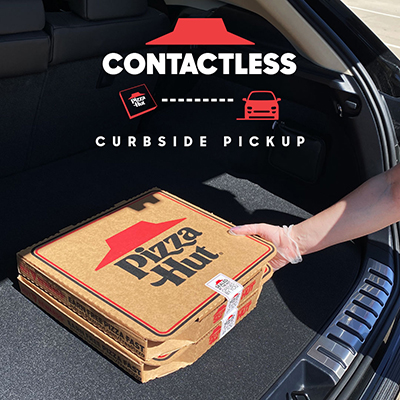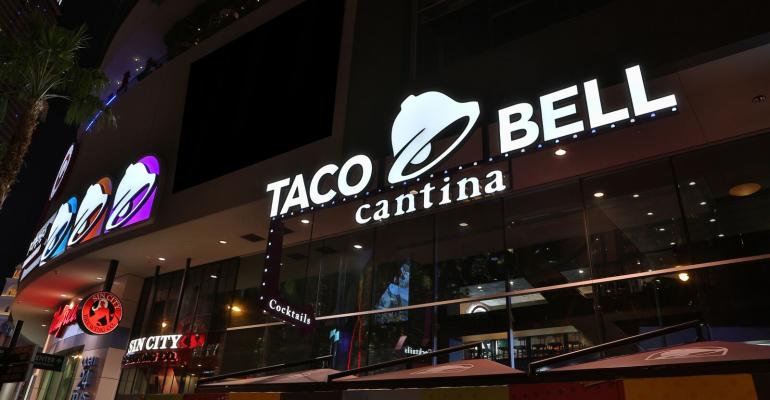Taco Bell, which has long been the bright spot in the Yum Brands portfolio, has been hit hard by stay-at-home orders prompted by COVID-19, Yum Brands said Wednesday during the company's first quarter conference call.
Same-store sales dropped 30% on average in the second half of March and into April at Taco Bell, Yum said. The declines were primarily driven by a drop in late-night and breakfast sales. In late March, some Taco Bell restaurants temporarily stopped serving breakfast.
“Their business has had the most impact because they have a breakfast business which our other businesses don't and because they were reliant on late-night,” CEO David Gibbs said. “The breakfast business is impacted when people aren't on the roads going to work. They're not going through your drive-thru for breakfast as much. And the late-night business is obviously impacted by people [not] out at bars and theaters.”
Still, Gibbs gave the Irvine, Calif.-based chain a shout out.
Before COVID-19, the chain was “chugging along at 6% same-store sales growth,” he said.
Taco Bell closed the first quarter with a 1% increase in same store sales.
The brand, along with KFC and Pizza Hut, are embracing established delivery, drive-thru and carryout channels to drive business during the pandemic, Yum leaders said.
For the quarter ended March 31, the Louisville, Ky.-based company logged a 7% decline in global same-store sales. The drop was driven primarily by declines at KFC and Pizza Hut, which logged global declines of 8% and 11%, respectively.
 Pizza Hut, which was struggling prior to the crisis, saw U.S. same-store sales decline 7%.
Pizza Hut, which was struggling prior to the crisis, saw U.S. same-store sales decline 7%.
Gibbs said COVID-19 has accelerated Pizza Hut's turnaround strategy, which is focused on delivery and carryout.
In recent weeks, Pizza Hut began offering contactless curbside pickup, modeling itself after a successful program launched at Pizza Hut restaurants in China.
The pizza chain, which closed 1,000 express units during the COVID-19 crisis, now offers contactless curbside pickup for online orders.
More than 60% of online delivery orders are now via contactless delivery, the Plano, Texas-based chain said earlier this month.
Gibbs noted that Pizza Hut “set a digital sales record” in the U.S. recently and did “more sales on a typical Friday” than on either of the last two Super Bowls which held the brand’s previous record.
“The brand is going through some rapid changes,” Gibbs said.
Though the company has been hit hard the pandemic, the quick-service restaurant company said it is seeing improving sales trends in late April.
During the quarter, the company completed its acquisition of The Habit Burger Grill.
The fast-casual burger chains, along with the company’s three iconic QSR brands, have met the challenge of pivoting to a low-contact ordering environment with drive-thru, curbside carryout and delivery, Gibbs said.
“Trends have improved significantly as we've moved through April. Certain markets have really figured out how to operate in this environment,” Gibbs said. “The stimulus impact on the consumers is obviously helping our business and helping build momentum there as well.”
Yum leaders declined to offer specifics on current second quarter sales trends.
Gibbs said the brand is taking cues from China’s “uneven” recovery, which is making it “difficult to forecast” sales trends.
At the peak of the global crisis, Yum Brands closed about 11,000 restaurants. During the early part of the crisis in the second half of March and into April, Yum’s global same-store sales fell by 30% on average.
Since then, about 1,000 have reopened with KFC preparing to reopen 100 locations next week in the United Kingdom. That has helped to drive momentum in the second quarter.
Adapting to a new normal of contactless ordering has been, and will be the key, to keeping operations sustainable during the crisis, leaders said.
“Our brands consistently stand for value and convenience and normalcy, all of which are highly sought out in these uncertain times and beyond,” Gibbs said.
When it comes to franchisees, Yum Brands Chief Financial Officer Chris Turner said it’s been “an all hands-on deck situation.”
The company is helping operators through royalty grace periods and capital deferrals.
“It's a really unprecedented situation and the pandemic is causing strain on our franchisees, particularly in markets where stores have been closed and we are working hard with them to help bridge to the other side,” Turner said.
In the U.S., he noted, about 60% of Yum’s franchisees operate one to three stores. Some have sought government assistance, though Turner did not provide specifics including revealing any amount of loans received through the Paycheck Protection Program.
To the extent it can, Turner said Yum has tried "to help our franchisees understand those programs and we appreciate that they are available."
He added: “Many of them are feeling the same stress that small businesses across the country are feeling through this crisis."
For those that are in real distress, Gibbs and Turner said that Yum is in talks with other franchisees and “outside buyers” who might be willing to acquire those struggling units.
“I think people recognize that Yum, given the skew towards off premise, is well-positioned to come out of this stronger. And there are a lot of outside people with capital that want to participate in that,” Gibbs said.
Overall, Gibbs said the company is giving consumers what they want during this pandemic: safety, convenience, contactless ordering and value.
“We're incredibly uniquely positioned to get through this and come out stronger. And that is our marching orders,” Gibbs said.
Total quarterly revenue of $1.26 billion compared to $1.25 billion in the previous quarter, same period. Net income fell to $83 million, compared to $262 million in the same period, last year.
For our most up-to-date coverage, visit the coronavirus homepage.
Learn lessons in leadership during a crisis from our panel of experts on Friday, May 1.
Contact Nancy Luna at [email protected]
Follow her on Twitter: @fastfoodmaven

